Building Trust within Employees: Leadership and Storytelling
VerifiedAdded on 2023/04/21
|5
|1690
|298
Report
AI Summary
This report analyzes the tools leaders can use to build trust and relationships with employees. It emphasizes the importance of transparency, authenticity, and participative communication. The report explores the use of storytelling as a key tool, highlighting its ability to connect with employees by sharing experiences and providing a vision for handling situations. It also discusses the need for leaders to lead by example, be open to feedback, and apply various leadership styles like democratic and transactional styles to foster trust and engagement. The report includes a case study of the BP oil spill, illustrating how a lack of transparency and effective communication can erode trust. Finally, it outlines a self-plan for building trust, emphasizing democratic leadership, storytelling, and open communication to achieve organizational goals. The report draws on various academic sources to support its claims.
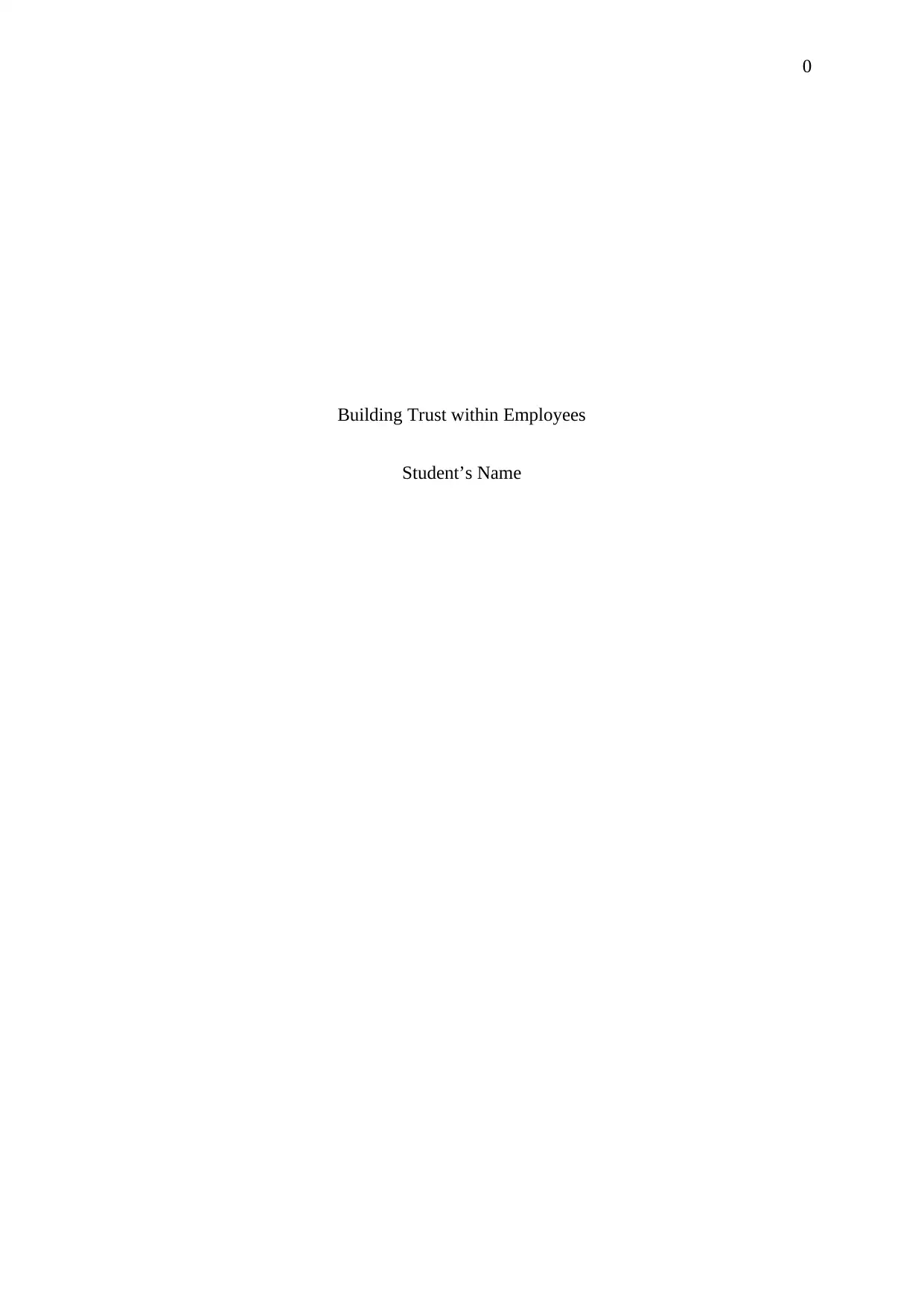
0
Building Trust within Employees
Student’s Name
Building Trust within Employees
Student’s Name
Paraphrase This Document
Need a fresh take? Get an instant paraphrase of this document with our AI Paraphraser
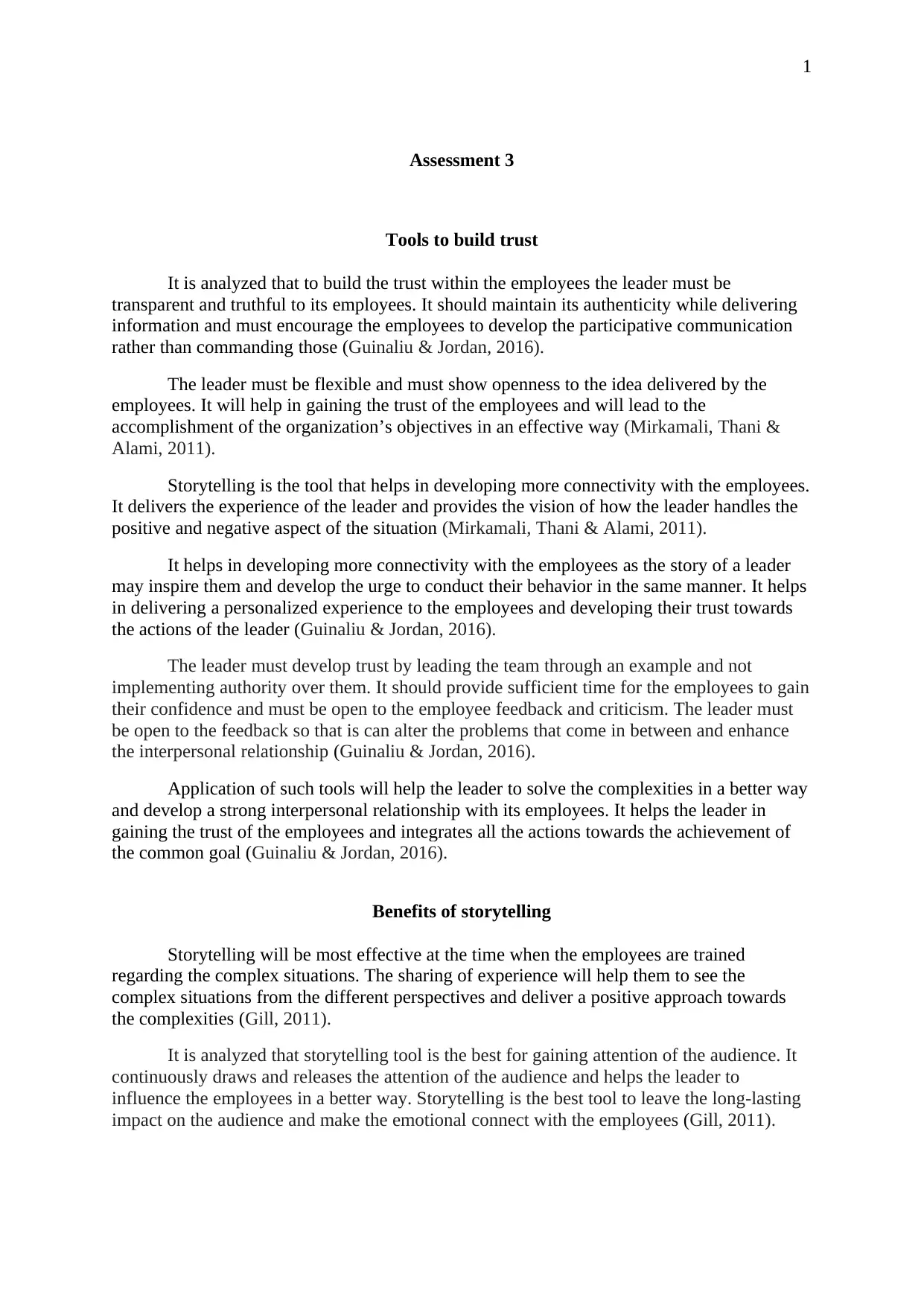
1
Assessment 3
Tools to build trust
It is analyzed that to build the trust within the employees the leader must be
transparent and truthful to its employees. It should maintain its authenticity while delivering
information and must encourage the employees to develop the participative communication
rather than commanding those (Guinaliu & Jordan, 2016).
The leader must be flexible and must show openness to the idea delivered by the
employees. It will help in gaining the trust of the employees and will lead to the
accomplishment of the organization’s objectives in an effective way (Mirkamali, Thani &
Alami, 2011).
Storytelling is the tool that helps in developing more connectivity with the employees.
It delivers the experience of the leader and provides the vision of how the leader handles the
positive and negative aspect of the situation (Mirkamali, Thani & Alami, 2011).
It helps in developing more connectivity with the employees as the story of a leader
may inspire them and develop the urge to conduct their behavior in the same manner. It helps
in delivering a personalized experience to the employees and developing their trust towards
the actions of the leader (Guinaliu & Jordan, 2016).
The leader must develop trust by leading the team through an example and not
implementing authority over them. It should provide sufficient time for the employees to gain
their confidence and must be open to the employee feedback and criticism. The leader must
be open to the feedback so that is can alter the problems that come in between and enhance
the interpersonal relationship (Guinaliu & Jordan, 2016).
Application of such tools will help the leader to solve the complexities in a better way
and develop a strong interpersonal relationship with its employees. It helps the leader in
gaining the trust of the employees and integrates all the actions towards the achievement of
the common goal (Guinaliu & Jordan, 2016).
Benefits of storytelling
Storytelling will be most effective at the time when the employees are trained
regarding the complex situations. The sharing of experience will help them to see the
complex situations from the different perspectives and deliver a positive approach towards
the complexities (Gill, 2011).
It is analyzed that storytelling tool is the best for gaining attention of the audience. It
continuously draws and releases the attention of the audience and helps the leader to
influence the employees in a better way. Storytelling is the best tool to leave the long-lasting
impact on the audience and make the emotional connect with the employees (Gill, 2011).
Assessment 3
Tools to build trust
It is analyzed that to build the trust within the employees the leader must be
transparent and truthful to its employees. It should maintain its authenticity while delivering
information and must encourage the employees to develop the participative communication
rather than commanding those (Guinaliu & Jordan, 2016).
The leader must be flexible and must show openness to the idea delivered by the
employees. It will help in gaining the trust of the employees and will lead to the
accomplishment of the organization’s objectives in an effective way (Mirkamali, Thani &
Alami, 2011).
Storytelling is the tool that helps in developing more connectivity with the employees.
It delivers the experience of the leader and provides the vision of how the leader handles the
positive and negative aspect of the situation (Mirkamali, Thani & Alami, 2011).
It helps in developing more connectivity with the employees as the story of a leader
may inspire them and develop the urge to conduct their behavior in the same manner. It helps
in delivering a personalized experience to the employees and developing their trust towards
the actions of the leader (Guinaliu & Jordan, 2016).
The leader must develop trust by leading the team through an example and not
implementing authority over them. It should provide sufficient time for the employees to gain
their confidence and must be open to the employee feedback and criticism. The leader must
be open to the feedback so that is can alter the problems that come in between and enhance
the interpersonal relationship (Guinaliu & Jordan, 2016).
Application of such tools will help the leader to solve the complexities in a better way
and develop a strong interpersonal relationship with its employees. It helps the leader in
gaining the trust of the employees and integrates all the actions towards the achievement of
the common goal (Guinaliu & Jordan, 2016).
Benefits of storytelling
Storytelling will be most effective at the time when the employees are trained
regarding the complex situations. The sharing of experience will help them to see the
complex situations from the different perspectives and deliver a positive approach towards
the complexities (Gill, 2011).
It is analyzed that storytelling tool is the best for gaining attention of the audience. It
continuously draws and releases the attention of the audience and helps the leader to
influence the employees in a better way. Storytelling is the best tool to leave the long-lasting
impact on the audience and make the emotional connect with the employees (Gill, 2011).
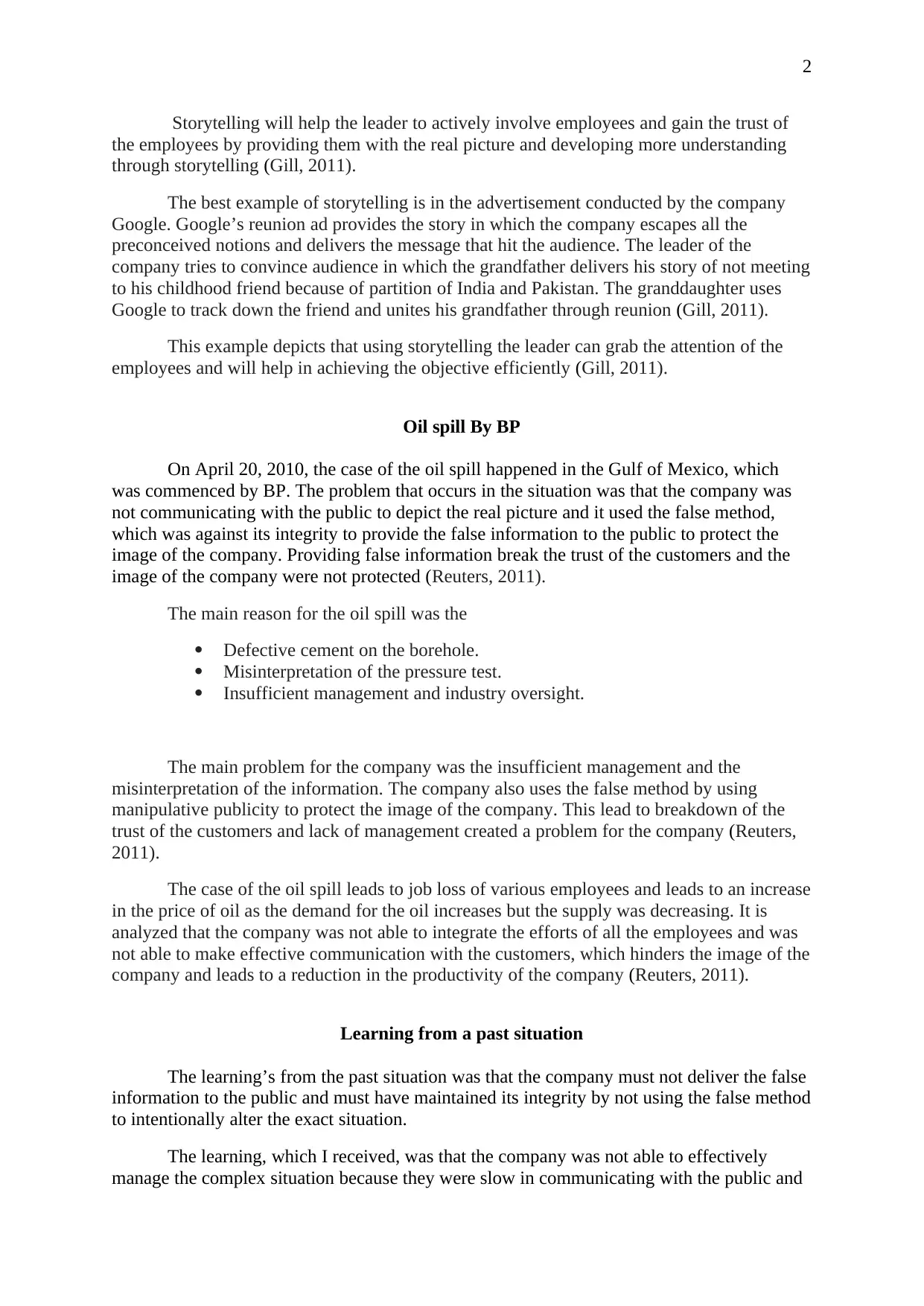
2
Storytelling will help the leader to actively involve employees and gain the trust of
the employees by providing them with the real picture and developing more understanding
through storytelling (Gill, 2011).
The best example of storytelling is in the advertisement conducted by the company
Google. Google’s reunion ad provides the story in which the company escapes all the
preconceived notions and delivers the message that hit the audience. The leader of the
company tries to convince audience in which the grandfather delivers his story of not meeting
to his childhood friend because of partition of India and Pakistan. The granddaughter uses
Google to track down the friend and unites his grandfather through reunion (Gill, 2011).
This example depicts that using storytelling the leader can grab the attention of the
employees and will help in achieving the objective efficiently (Gill, 2011).
Oil spill By BP
On April 20, 2010, the case of the oil spill happened in the Gulf of Mexico, which
was commenced by BP. The problem that occurs in the situation was that the company was
not communicating with the public to depict the real picture and it used the false method,
which was against its integrity to provide the false information to the public to protect the
image of the company. Providing false information break the trust of the customers and the
image of the company were not protected (Reuters, 2011).
The main reason for the oil spill was the
Defective cement on the borehole.
Misinterpretation of the pressure test.
Insufficient management and industry oversight.
The main problem for the company was the insufficient management and the
misinterpretation of the information. The company also uses the false method by using
manipulative publicity to protect the image of the company. This lead to breakdown of the
trust of the customers and lack of management created a problem for the company (Reuters,
2011).
The case of the oil spill leads to job loss of various employees and leads to an increase
in the price of oil as the demand for the oil increases but the supply was decreasing. It is
analyzed that the company was not able to integrate the efforts of all the employees and was
not able to make effective communication with the customers, which hinders the image of the
company and leads to a reduction in the productivity of the company (Reuters, 2011).
Learning from a past situation
The learning’s from the past situation was that the company must not deliver the false
information to the public and must have maintained its integrity by not using the false method
to intentionally alter the exact situation.
The learning, which I received, was that the company was not able to effectively
manage the complex situation because they were slow in communicating with the public and
Storytelling will help the leader to actively involve employees and gain the trust of
the employees by providing them with the real picture and developing more understanding
through storytelling (Gill, 2011).
The best example of storytelling is in the advertisement conducted by the company
Google. Google’s reunion ad provides the story in which the company escapes all the
preconceived notions and delivers the message that hit the audience. The leader of the
company tries to convince audience in which the grandfather delivers his story of not meeting
to his childhood friend because of partition of India and Pakistan. The granddaughter uses
Google to track down the friend and unites his grandfather through reunion (Gill, 2011).
This example depicts that using storytelling the leader can grab the attention of the
employees and will help in achieving the objective efficiently (Gill, 2011).
Oil spill By BP
On April 20, 2010, the case of the oil spill happened in the Gulf of Mexico, which
was commenced by BP. The problem that occurs in the situation was that the company was
not communicating with the public to depict the real picture and it used the false method,
which was against its integrity to provide the false information to the public to protect the
image of the company. Providing false information break the trust of the customers and the
image of the company were not protected (Reuters, 2011).
The main reason for the oil spill was the
Defective cement on the borehole.
Misinterpretation of the pressure test.
Insufficient management and industry oversight.
The main problem for the company was the insufficient management and the
misinterpretation of the information. The company also uses the false method by using
manipulative publicity to protect the image of the company. This lead to breakdown of the
trust of the customers and lack of management created a problem for the company (Reuters,
2011).
The case of the oil spill leads to job loss of various employees and leads to an increase
in the price of oil as the demand for the oil increases but the supply was decreasing. It is
analyzed that the company was not able to integrate the efforts of all the employees and was
not able to make effective communication with the customers, which hinders the image of the
company and leads to a reduction in the productivity of the company (Reuters, 2011).
Learning from a past situation
The learning’s from the past situation was that the company must not deliver the false
information to the public and must have maintained its integrity by not using the false method
to intentionally alter the exact situation.
The learning, which I received, was that the company was not able to effectively
manage the complex situation because they were slow in communicating with the public and
⊘ This is a preview!⊘
Do you want full access?
Subscribe today to unlock all pages.

Trusted by 1+ million students worldwide
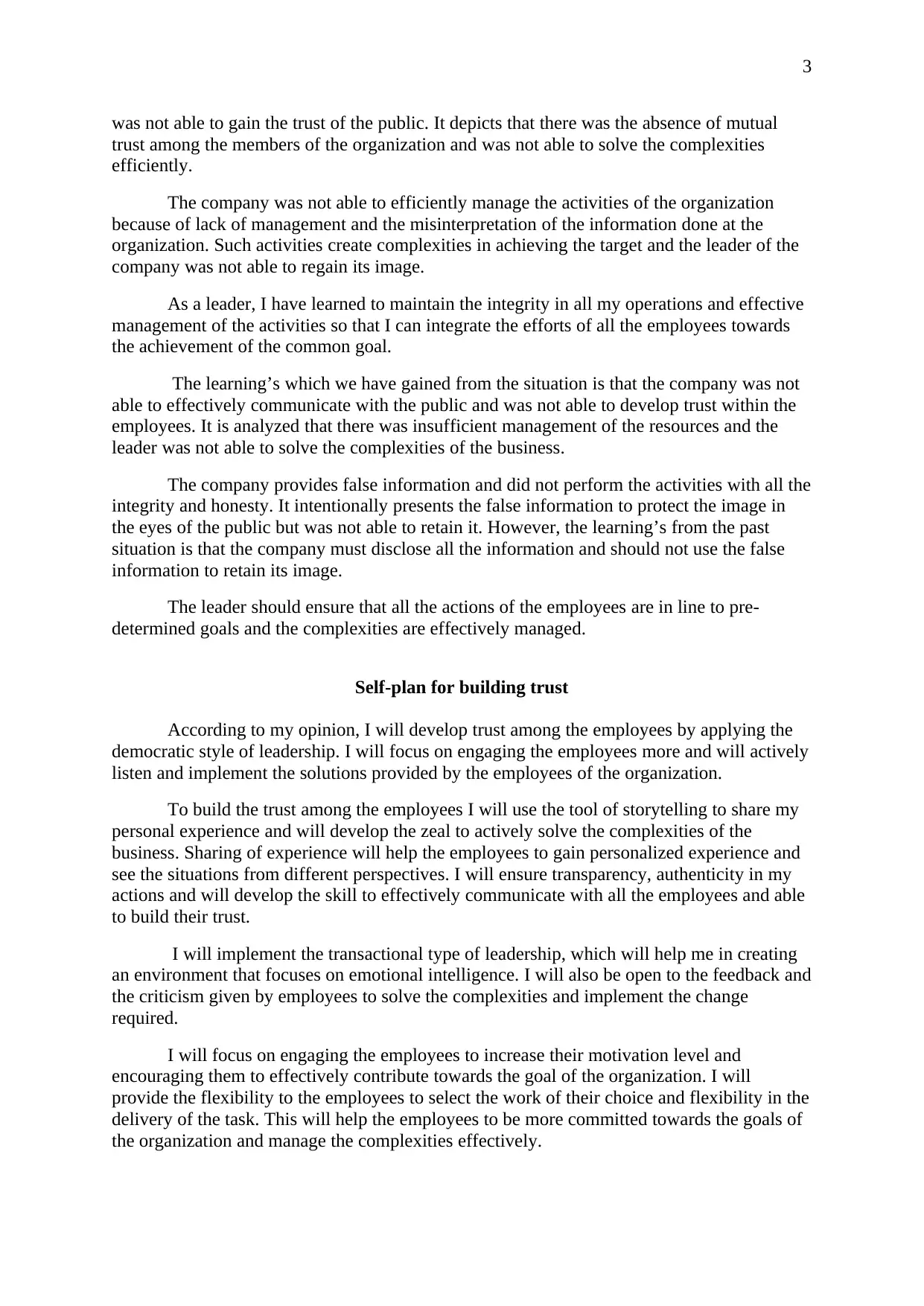
3
was not able to gain the trust of the public. It depicts that there was the absence of mutual
trust among the members of the organization and was not able to solve the complexities
efficiently.
The company was not able to efficiently manage the activities of the organization
because of lack of management and the misinterpretation of the information done at the
organization. Such activities create complexities in achieving the target and the leader of the
company was not able to regain its image.
As a leader, I have learned to maintain the integrity in all my operations and effective
management of the activities so that I can integrate the efforts of all the employees towards
the achievement of the common goal.
The learning’s which we have gained from the situation is that the company was not
able to effectively communicate with the public and was not able to develop trust within the
employees. It is analyzed that there was insufficient management of the resources and the
leader was not able to solve the complexities of the business.
The company provides false information and did not perform the activities with all the
integrity and honesty. It intentionally presents the false information to protect the image in
the eyes of the public but was not able to retain it. However, the learning’s from the past
situation is that the company must disclose all the information and should not use the false
information to retain its image.
The leader should ensure that all the actions of the employees are in line to pre-
determined goals and the complexities are effectively managed.
Self-plan for building trust
According to my opinion, I will develop trust among the employees by applying the
democratic style of leadership. I will focus on engaging the employees more and will actively
listen and implement the solutions provided by the employees of the organization.
To build the trust among the employees I will use the tool of storytelling to share my
personal experience and will develop the zeal to actively solve the complexities of the
business. Sharing of experience will help the employees to gain personalized experience and
see the situations from different perspectives. I will ensure transparency, authenticity in my
actions and will develop the skill to effectively communicate with all the employees and able
to build their trust.
I will implement the transactional type of leadership, which will help me in creating
an environment that focuses on emotional intelligence. I will also be open to the feedback and
the criticism given by employees to solve the complexities and implement the change
required.
I will focus on engaging the employees to increase their motivation level and
encouraging them to effectively contribute towards the goal of the organization. I will
provide the flexibility to the employees to select the work of their choice and flexibility in the
delivery of the task. This will help the employees to be more committed towards the goals of
the organization and manage the complexities effectively.
was not able to gain the trust of the public. It depicts that there was the absence of mutual
trust among the members of the organization and was not able to solve the complexities
efficiently.
The company was not able to efficiently manage the activities of the organization
because of lack of management and the misinterpretation of the information done at the
organization. Such activities create complexities in achieving the target and the leader of the
company was not able to regain its image.
As a leader, I have learned to maintain the integrity in all my operations and effective
management of the activities so that I can integrate the efforts of all the employees towards
the achievement of the common goal.
The learning’s which we have gained from the situation is that the company was not
able to effectively communicate with the public and was not able to develop trust within the
employees. It is analyzed that there was insufficient management of the resources and the
leader was not able to solve the complexities of the business.
The company provides false information and did not perform the activities with all the
integrity and honesty. It intentionally presents the false information to protect the image in
the eyes of the public but was not able to retain it. However, the learning’s from the past
situation is that the company must disclose all the information and should not use the false
information to retain its image.
The leader should ensure that all the actions of the employees are in line to pre-
determined goals and the complexities are effectively managed.
Self-plan for building trust
According to my opinion, I will develop trust among the employees by applying the
democratic style of leadership. I will focus on engaging the employees more and will actively
listen and implement the solutions provided by the employees of the organization.
To build the trust among the employees I will use the tool of storytelling to share my
personal experience and will develop the zeal to actively solve the complexities of the
business. Sharing of experience will help the employees to gain personalized experience and
see the situations from different perspectives. I will ensure transparency, authenticity in my
actions and will develop the skill to effectively communicate with all the employees and able
to build their trust.
I will implement the transactional type of leadership, which will help me in creating
an environment that focuses on emotional intelligence. I will also be open to the feedback and
the criticism given by employees to solve the complexities and implement the change
required.
I will focus on engaging the employees to increase their motivation level and
encouraging them to effectively contribute towards the goal of the organization. I will
provide the flexibility to the employees to select the work of their choice and flexibility in the
delivery of the task. This will help the employees to be more committed towards the goals of
the organization and manage the complexities effectively.
Paraphrase This Document
Need a fresh take? Get an instant paraphrase of this document with our AI Paraphraser
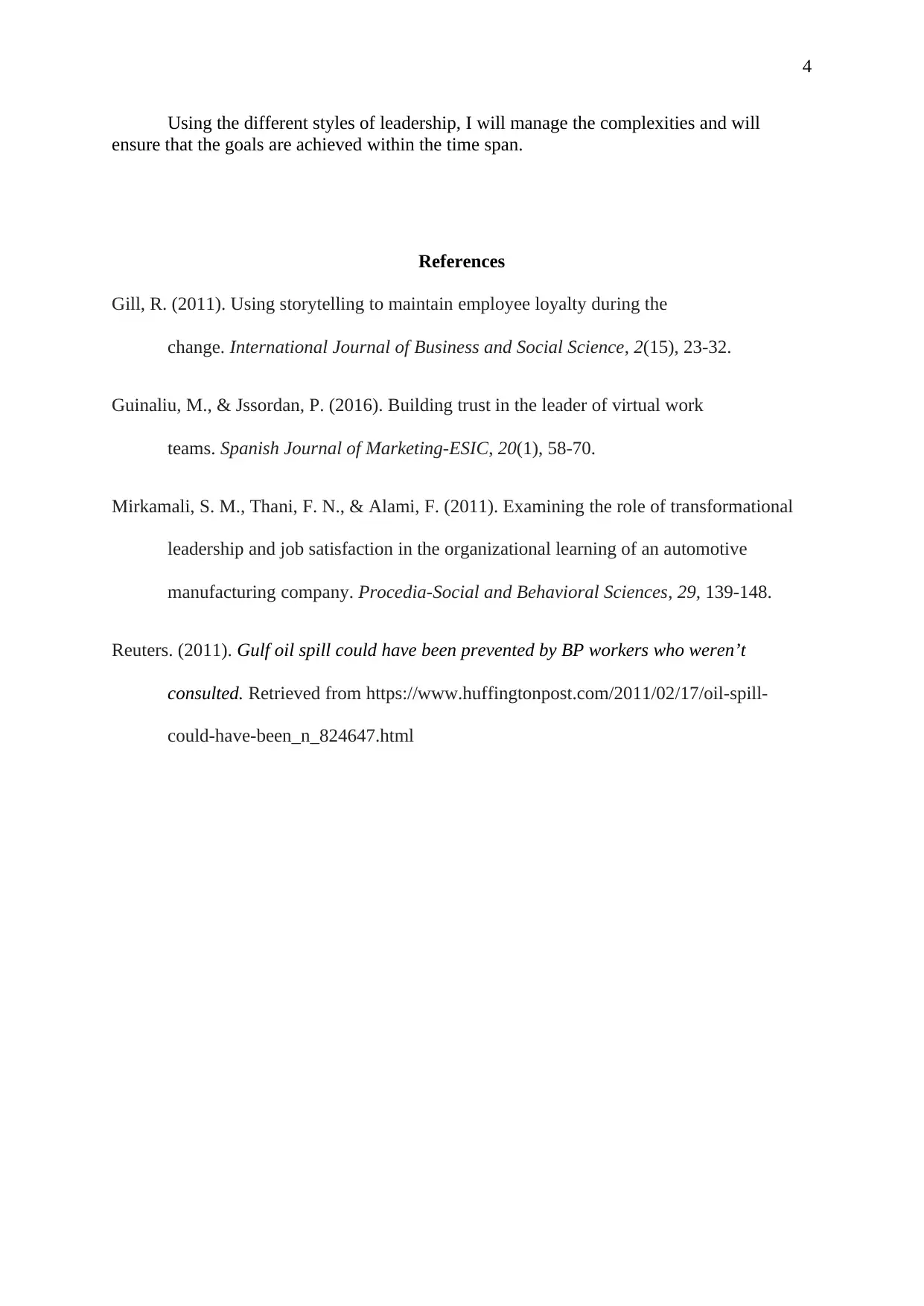
4
Using the different styles of leadership, I will manage the complexities and will
ensure that the goals are achieved within the time span.
References
Gill, R. (2011). Using storytelling to maintain employee loyalty during the
change. International Journal of Business and Social Science, 2(15), 23-32.
Guinaliu, M., & Jssordan, P. (2016). Building trust in the leader of virtual work
teams. Spanish Journal of Marketing-ESIC, 20(1), 58-70.
Mirkamali, S. M., Thani, F. N., & Alami, F. (2011). Examining the role of transformational
leadership and job satisfaction in the organizational learning of an automotive
manufacturing company. Procedia-Social and Behavioral Sciences, 29, 139-148.
Reuters. (2011). Gulf oil spill could have been prevented by BP workers who weren’t
consulted. Retrieved from https://www.huffingtonpost.com/2011/02/17/oil-spill-
could-have-been_n_824647.html
Using the different styles of leadership, I will manage the complexities and will
ensure that the goals are achieved within the time span.
References
Gill, R. (2011). Using storytelling to maintain employee loyalty during the
change. International Journal of Business and Social Science, 2(15), 23-32.
Guinaliu, M., & Jssordan, P. (2016). Building trust in the leader of virtual work
teams. Spanish Journal of Marketing-ESIC, 20(1), 58-70.
Mirkamali, S. M., Thani, F. N., & Alami, F. (2011). Examining the role of transformational
leadership and job satisfaction in the organizational learning of an automotive
manufacturing company. Procedia-Social and Behavioral Sciences, 29, 139-148.
Reuters. (2011). Gulf oil spill could have been prevented by BP workers who weren’t
consulted. Retrieved from https://www.huffingtonpost.com/2011/02/17/oil-spill-
could-have-been_n_824647.html
1 out of 5
Your All-in-One AI-Powered Toolkit for Academic Success.
+13062052269
info@desklib.com
Available 24*7 on WhatsApp / Email
![[object Object]](/_next/static/media/star-bottom.7253800d.svg)
Unlock your academic potential
Copyright © 2020–2025 A2Z Services. All Rights Reserved. Developed and managed by ZUCOL.


